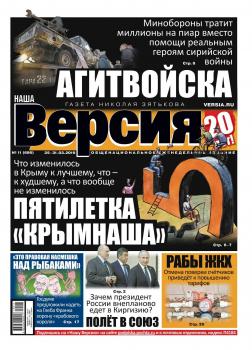MREADZ.COM - много разных книг на любой вкус
Скачивание или чтение онлайн электронных книг.Караван Историй. Коллекция 03-2019
Редакция журнала Караван Историй. Коллекция
«Коллекция Каравана историй» – самые нашумевшие и мегапопулярные материалы из архива «Каравана историй», а также фотопроекты Екатерины Рождественской, которые больше всего понравились читателям. В каждом номере: 10 историй, которые потрясли мир: романы, мегаскандалы, загадочные катастрофы, а также эксклюзивные интервью со знаменитостями.
Marie Claire 04-2019
«Marie Claire» – журнал для женщин, посвященный моде, красоте и другим не менее важным и значительным темам из жизни современной женщины. На страницах издания вы найдете «глянцевые» рубрики, которые стали классикой подобных журналов – съемки моды, обзоры косметических новинок. Кроме того, в каждом номере захватывающие интервью и эксклюзивные репортажи.
Счастливые Родители 04-2019
Редакция журнала Счастливые Родители
«Счастливые родители» – журнал, который давно стал незаменимым помощником для молодых родителей. На страницах издания вы найдете: рекомендации и материалы, написанные лучшими российскими докторами ( гинекологами, педиатрами, диетологами, детскими психологами), они отвечают на самые насущные вопросы, касающиеся беременности и первых лет жизни ребенка. Кроме того, в каждом номере рекомендации российских и зарубежных специалистов, касающиеся родов, питания и ухода за ребенком. Корреспонденты «Счастливых родителей» знакомят своих читателей с новинками модных и актуальных товаров для детей, а также последними научными достижениями в области педиатрии, акушерства, психологии и диетологии.
Наша Версия 08-2019
Еженедельная газета «Совершенно Секретно – Версия» была основана в 1998 году известным российским журналистом Артёмом Боровиком. Журналистский коллектив издания прославился рядом громких расследований, публикацией сенсационных материалов. В 2005 году газета получила новое имя – «Наша Версия».Общероссийская еженедельная газета «Наша Версия» сегодня – это один из ведущих еженедельников журналистских расследований – жесткий и информативный, остроумный и понятный.Издание выходит на 24 полосах формата А-3 общим тиражом 170 тысяч экземпляров и распространяется во всех регионах России, а также на территории ближнего и дальнего зарубежья.
Наша Версия 09-2019
Еженедельная газета «Совершенно Секретно – Версия» была основана в 1998 году известным российским журналистом Артёмом Боровиком. Журналистский коллектив издания прославился рядом громких расследований, публикацией сенсационных материалов. В 2005 году газета получила новое имя – «Наша Версия».Общероссийская еженедельная газета «Наша Версия» сегодня – это один из ведущих еженедельников журналистских расследований – жесткий и информативный, остроумный и понятный.Издание выходит на 24 полосах формата А-3 общим тиражом 170 тысяч экземпляров и распространяется во всех регионах России, а также на территории ближнего и дальнего зарубежья.
Наша Версия 11-2019
Еженедельная газета «Совершенно Секретно – Версия» была основана в 1998 году известным российским журналистом Артёмом Боровиком. Журналистский коллектив издания прославился рядом громких расследований, публикацией сенсационных материалов. В 2005 году газета получила новое имя – «Наша Версия».Общероссийская еженедельная газета «Наша Версия» сегодня – это один из ведущих еженедельников журналистских расследований – жесткий и информативный, остроумный и понятный.Издание выходит на 24 полосах формата А-3 общим тиражом 170 тысяч экземпляров и распространяется во всех регионах России, а также на территории ближнего и дальнего зарубежья.
Ежедневная Деловая Газета Рбк 30-2019
Редакция газеты Ежедневная деловая газета РБК
Общественно-политическая деловая газета, которая знакомит читателей с ситуацией на финансовом рынке, а также иных отраслях экономики. На страницах издания вы найдете аналитические статьи, которые раскрывают реальное положение дел, не только в ведущих компаниях страны, но и малом бизнесе. Основные темы каждого номера: «Развитие и становление бизнеса в нашей стране» (разбор конфликтных ситуаций в бизнесе, примеры их решения, грамотная конкуренция, некорректная практика в бизнесе и т.д.); «Положение отечественного бизнеса и его роль в мировой деловой системе, а также прогнозы на будущее»; «Самые прибыльные направления, которые можно выбрать, чтобы создать перспективный бизнес в России и за границей»; «Как повысить конкурентоспособность отечественного бизнеса».
Ежедневная Деловая Газета Рбк 31-2019
Редакция газеты Ежедневная деловая газета РБК
Общественно-политическая деловая газета, которая знакомит читателей с ситуацией на финансовом рынке, а также иных отраслях экономики. На страницах издания вы найдете аналитические статьи, которые раскрывают реальное положение дел, не только в ведущих компаниях страны, но и малом бизнесе. Основные темы каждого номера: «Развитие и становление бизнеса в нашей стране» (разбор конфликтных ситуаций в бизнесе, примеры их решения, грамотная конкуренция, некорректная практика в бизнесе и т.д.); «Положение отечественного бизнеса и его роль в мировой деловой системе, а также прогнозы на будущее»; «Самые прибыльные направления, которые можно выбрать, чтобы создать перспективный бизнес в России и за границей»; «Как повысить конкурентоспособность отечественного бизнеса».
Ежедневная Деловая Газета Рбк 32-2019
Редакция газеты Ежедневная деловая газета РБК
Общественно-политическая деловая газета, которая знакомит читателей с ситуацией на финансовом рынке, а также иных отраслях экономики. На страницах издания вы найдете аналитические статьи, которые раскрывают реальное положение дел, не только в ведущих компаниях страны, но и малом бизнесе. Основные темы каждого номера: «Развитие и становление бизнеса в нашей стране» (разбор конфликтных ситуаций в бизнесе, примеры их решения, грамотная конкуренция, некорректная практика в бизнесе и т.д.); «Положение отечественного бизнеса и его роль в мировой деловой системе, а также прогнозы на будущее»; «Самые прибыльные направления, которые можно выбрать, чтобы создать перспективный бизнес в России и за границей»; «Как повысить конкурентоспособность отечественного бизнеса».
Ежедневная Деловая Газета Рбк 33-2019
Редакция газеты Ежедневная деловая газета РБК
Общественно-политическая деловая газета, которая знакомит читателей с ситуацией на финансовом рынке, а также иных отраслях экономики. На страницах издания вы найдете аналитические статьи, которые раскрывают реальное положение дел, не только в ведущих компаниях страны, но и малом бизнесе. Основные темы каждого номера: «Развитие и становление бизнеса в нашей стране» (разбор конфликтных ситуаций в бизнесе, примеры их решения, грамотная конкуренция, некорректная практика в бизнесе и т.д.); «Положение отечественного бизнеса и его роль в мировой деловой системе, а также прогнозы на будущее»; «Самые прибыльные направления, которые можно выбрать, чтобы создать перспективный бизнес в России и за границей»; «Как повысить конкурентоспособность отечественного бизнеса».









